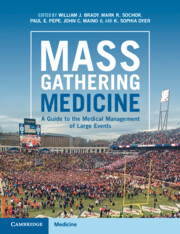937 results
Human-animal interactions and machine-animal interactions in animals under human care: A summary of stakeholder and researcher perceptions and future directions
-
- Journal:
- Animal Welfare / Volume 33 / 2024
- Published online by Cambridge University Press:
- 09 May 2024, e27
-
- Article
-
- You have access
- Open access
- HTML
- Export citation
Contributors
-
- Book:
- Mass Gathering Medicine
- Published online:
- 11 April 2024
- Print publication:
- 18 April 2024, pp ix-xii
-
- Chapter
- Export citation
Preface
-
- Book:
- Mass Gathering Medicine
- Published online:
- 11 April 2024
- Print publication:
- 18 April 2024, pp xv-xvi
-
- Chapter
- Export citation
Appendix 2 - Suggested Medications: Infield Medical Center
- from Chapter 13 - Mass Gathering Events: Motor Sport Events
-
- Book:
- Mass Gathering Medicine
- Published online:
- 11 April 2024
- Print publication:
- 18 April 2024, pp 195-195
-
- Chapter
- Export citation
Dedication
-
- Book:
- Mass Gathering Medicine
- Published online:
- 11 April 2024
- Print publication:
- 18 April 2024, pp v-vi
-
- Chapter
- Export citation
Appendix 3 - NASCAR Recommended Equipment for Infield Medical Center from NASCAR 2012 Medical Verification Form
- from Chapter 13 - Mass Gathering Events: Motor Sport Events
-
- Book:
- Mass Gathering Medicine
- Published online:
- 11 April 2024
- Print publication:
- 18 April 2024, pp 196-198
-
- Chapter
- Export citation
Appendix 1 - Motor-Sports Concussion Guidelines
- from Chapter 13 - Mass Gathering Events: Motor Sport Events
-
- Book:
- Mass Gathering Medicine
- Published online:
- 11 April 2024
- Print publication:
- 18 April 2024, pp 194-194
-
- Chapter
- Export citation
Foreword
-
- Book:
- Mass Gathering Medicine
- Published online:
- 11 April 2024
- Print publication:
- 18 April 2024, pp xiii-xiv
-
- Chapter
- Export citation
Index
-
- Book:
- Mass Gathering Medicine
- Published online:
- 11 April 2024
- Print publication:
- 18 April 2024, pp 406-418
-
- Chapter
- Export citation
Copyright page
-
- Book:
- Mass Gathering Medicine
- Published online:
- 11 April 2024
- Print publication:
- 18 April 2024, pp iv-iv
-
- Chapter
- Export citation
Contents
-
- Book:
- Mass Gathering Medicine
- Published online:
- 11 April 2024
- Print publication:
- 18 April 2024, pp vii-viii
-
- Chapter
- Export citation
Nasal obstruction symptom evaluation score outcomes in patients awaiting septoplasty at a tertiary ENT centre
-
- Journal:
- The Journal of Laryngology & Otology , First View
- Published online by Cambridge University Press:
- 16 April 2024, pp. 1-4
-
- Article
- Export citation

Mass Gathering Medicine
- A Guide to the Medical Management of Large Events
-
- Published online:
- 11 April 2024
- Print publication:
- 18 April 2024
Estimation of Clay Proportions in Mixtures by X-Ray Diffraction and Computerized Chemical Mass Balance
-
- Journal:
- Clays and Clay Minerals / Volume 32 / Issue 1 / February 1984
- Published online by Cambridge University Press:
- 02 April 2024, pp. 19-28
-
- Article
- Export citation
Head and Neck Cancer: United Kingdom National Multidisciplinary Guidelines, Sixth Edition
-
- Journal:
- The Journal of Laryngology & Otology / Volume 138 / Issue S1 / April 2024
- Published online by Cambridge University Press:
- 14 March 2024, pp. S1-S224
- Print publication:
- April 2024
-
- Article
-
- You have access
- Open access
- HTML
- Export citation
The Surface Coulomb Energy and Proton Coulomb Potentials of Pyrophyllite {010}, {110}, {100}, and {130} EDGES
-
- Journal:
- Clays and Clay Minerals / Volume 41 / Issue 3 / June 1993
- Published online by Cambridge University Press:
- 28 February 2024, pp. 305-316
-
- Article
- Export citation
COVID-19 passenger screening to reduce travel risk and translocation of disease
-
- Journal:
- Epidemiology & Infection / Volume 152 / 2024
- Published online by Cambridge University Press:
- 08 February 2024, e36
-
- Article
-
- You have access
- Open access
- HTML
- Export citation
Near-source passive sampling for monitoring viral outbreaks within a university residential setting
-
- Journal:
- Epidemiology & Infection / Volume 152 / 2024
- Published online by Cambridge University Press:
- 08 February 2024, e31
-
- Article
-
- You have access
- Open access
- HTML
- Export citation
P102: Supporting Informal Carers to Undertake Regular Physical Activity from Home: a Co-design and Prototype Development Study of a novel app, “CareFit”
-
- Journal:
- International Psychogeriatrics / Volume 35 / Issue S1 / December 2023
- Published online by Cambridge University Press:
- 02 February 2024, p. 251
-
- Article
-
- You have access
- Export citation
Chapter 45 - Case Study 1: Caring for Teams – An Organisation-Wide Approach to Wellbeing, Psychosocial Care, and Mental Healthcare
- from Section 5 - Sustaining and Caring for Staff During Emergencies
-
-
- Book:
- Major Incidents, Pandemics and Mental Health
- Published online:
- 11 January 2024
- Print publication:
- 01 February 2024, pp 337-344
-
- Chapter
- Export citation

